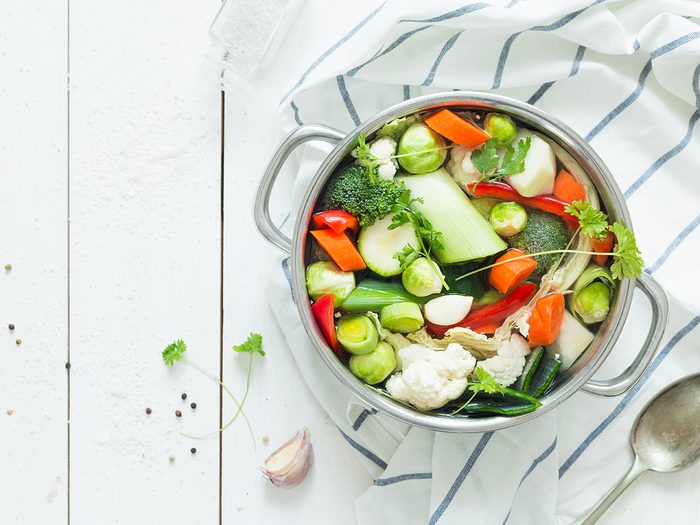
How can veggies help with weight loss?
If you’re trying to lose weight, you don’t need to—nor should you—only eat veggies to do that. However, increasing your vegetable intake can help support a healthy diet plan.
“Non-starchy vegetables support an experience of feeling full after a healthy meal and add a bounty of various vitamins, minerals, and other micronutrients,” says registered dietitian Yulia Brockdorf, a fellow of the Academy of Integrative Health and Medicine in private practice in Hillsboro, Oregon.
They also have a low glycemic load and glycemic index and are lower in calories and carbohydrates. Vegetables also tend to be nutrient-dense, which means these veggies have a lot of good-for-you nutrition but are relatively low in calories per serving size.
Let’s not forget the fibre factor. Fibre takes a bit longer to digest in the body, so you’ll feel fuller longer. On top of that, these veggies are also some of the most hydrating foods you can eat without drinking water.
We asked registered dietitians to share the best vegetables for weight loss. Plus, how to eat them and why they are a good addition to any meal plan.
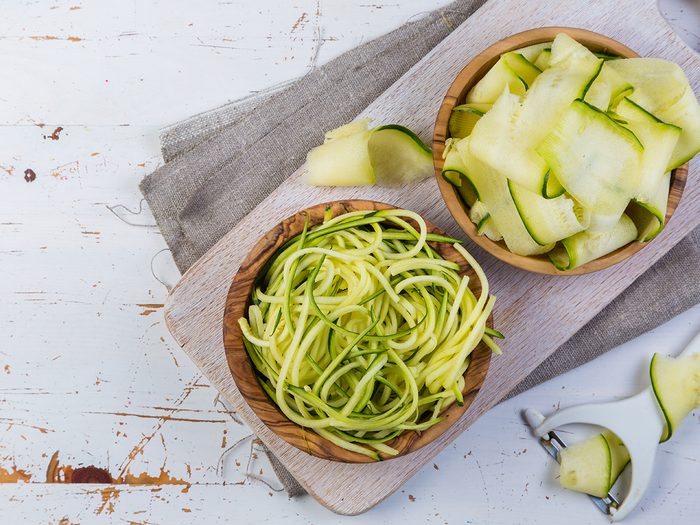
Zucchini
Whether you grow your own zucchini, buy them, or a neighbour leaves a dozen on your porch, visions of moist and delicious chocolate chip zucchini bread come to mind, but there are healthier—and just as delicious ways to eat it.
Zucchini “zoodles” are a great substitute for higher refined carb pasta noodles. They’re lower in calories and ideal as a gluten-free option, says registered dietitian Kristine van Workum, with Health First Medical Group in Melbourne, Florida.
One medium zucchini (with skin on) has around 33 calories, two grams of fibre, and 58 percent of the recommended daily value for vitamin C, according to the U.S. Department of Agriculture (USDA).
“I often say, what do you want more—a piece of Italian bread or the pasta? It’s kind of all or nothing for many people, which can lead to inconsistency and stress,” she says.
Try your hand at these delicious vegetarian recipes.
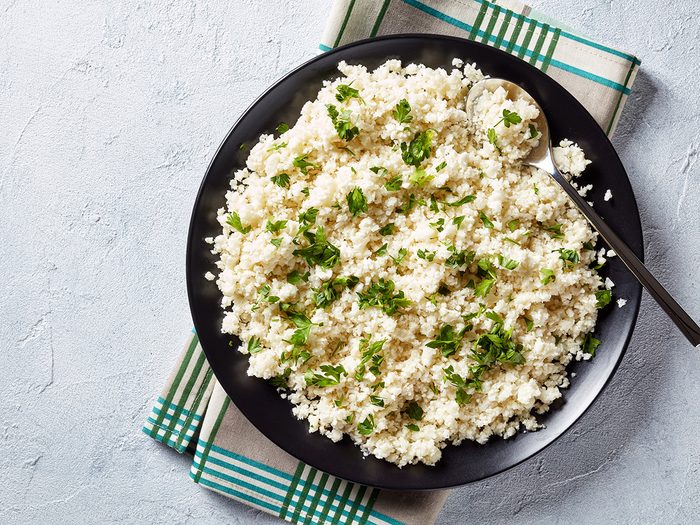
Cauliflower
When you’re craving higher-calorie starchy potatoes or white rice, consider trying cauliflower instead.
You can transform cauliflower into a pizza crust, cauliflower rice, or substitute one-half of the potatoes in a recipe for “mashed potatoes,” says Van Workum.
You’ll save calories and carbs, plus get more fibre toward your daily goal by making the switch, making it one of the best vegetables for weight loss. For example, one-half cup of white rice has about 100 calories, 23 grams of carbs, and zippo when it comes to fibre.
On the other hand, cauliflower has only five grams of carbs and 27 calories, and two grams of fibre. Plus, cauliflower is rich in vitamin C, vitamin K, and folate.
These are the foods nutritionists never order at fast food restaurants!
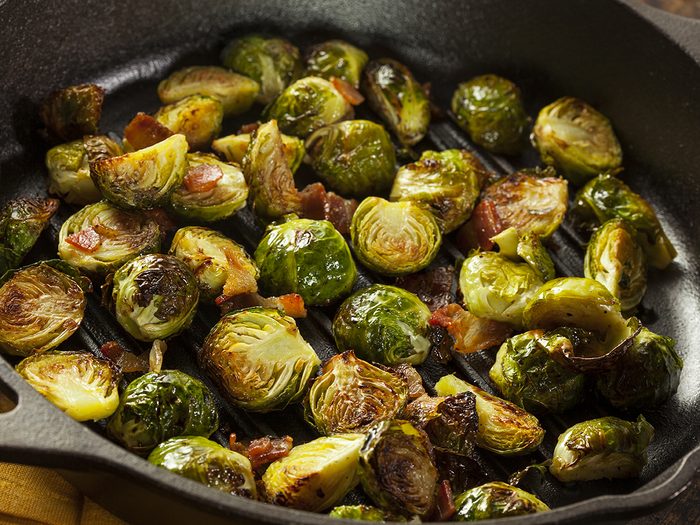
Brussels sprouts
Brussels sprouts are delicious and they’re popping up as tempting roasted and crispy appetizers on restaurant menus.
And that’s just how registered dietitian Melissa Majumdar likes to eat them. She’s a spokesperson for the Academy of Nutrition and Dietetics and bariatric coordinator at Emory University Hospital Midtown, Atlanta, Georgia.
“A little bit of olive oil, salt, and pepper goes a long way with Brussel sprouts, and make a great side to some grilled fish,” says Majumdar. Taste aside, they’re a substantial and hefty veggie Van Workum says, with a low-calorie price tag of about 38 calories per cup.
“As cruciferous vegetables, they are liked [for] helping decrease inflammation,” adds Van Workum. Not to mention their other vitamins and minerals and omega-3 fatty acids.
Did you know about these health benefits of Brussels sprouts?
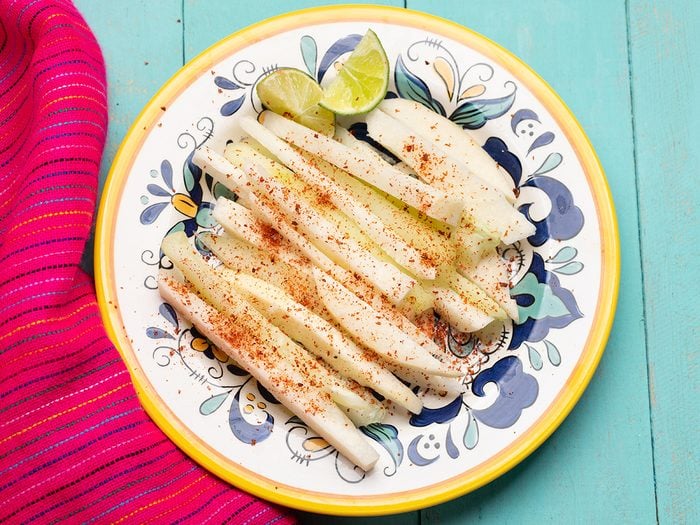
Jicama
You can’t beat the gratifying crunch of jicama. It really makes you feel like your eating something hardy and filling.
With 90 percent water content, one cup of sliced jicama contains 46 calories and a sizable six grams of fibre, per the USDA. It’s an excellent source of inulin, a type of fibre that supports healthy gastrointestinal flora.
“Jicama supports weight loss and helps with improved insulin sensitivity and is an outstanding low-calorie snack,” says Brockdorf.
She likes to eat it with paprika and a splash of lime juice in place of potato chips. Try adding jicama for a tasty crunch to salads and coleslaw or dipping in guacamole, suggests Majumdar.
Learn how to read Canada’s nutrition facts labels.
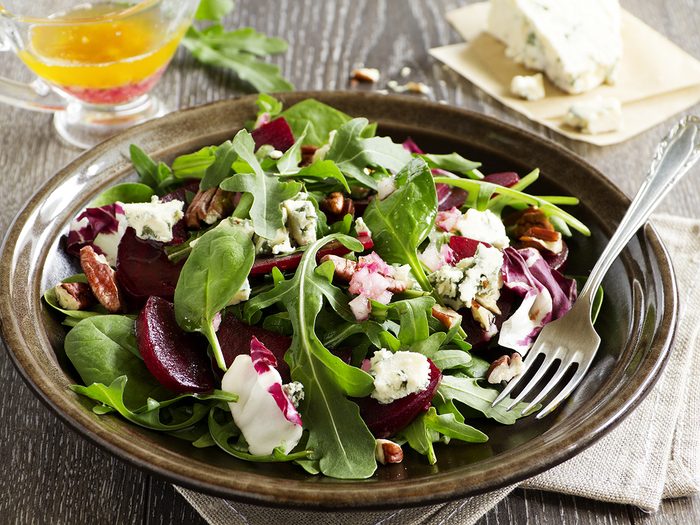
Beets
No kidding, beets could curb your sweet cravings. They’re a naturally sweet root veggie that is often overlooked, which is surprising because you can’t “beet’ the weight loss and health benefits they provide. In fact, beets can help with your fat-burning efforts when it comes to exercise.
“There’s been some research on beets and athletic performance,” says Van Workum. The nitrates in beets can improve endurance, and they are high in antioxidants, according to the journal Nutrients.
While beets are considered a starchy veggie, they are still seven grams lower in carbs than potatoes, and a half-cup is a mere 38 calories.
Buy them raw or save prep time and buy the ready-to-eat variety in the produce section. Roasting them brings out the natural sugars, so they’re tasty as is. Or toss them on a bed of spring mix greens with a bit of goat cheese, walnuts, and vinaigrette.
If you have gout, however, check with your doctor before eating them, as beets contain oxalate, which can contribute to gout.
This is what you need to know about the health benefits of beets.
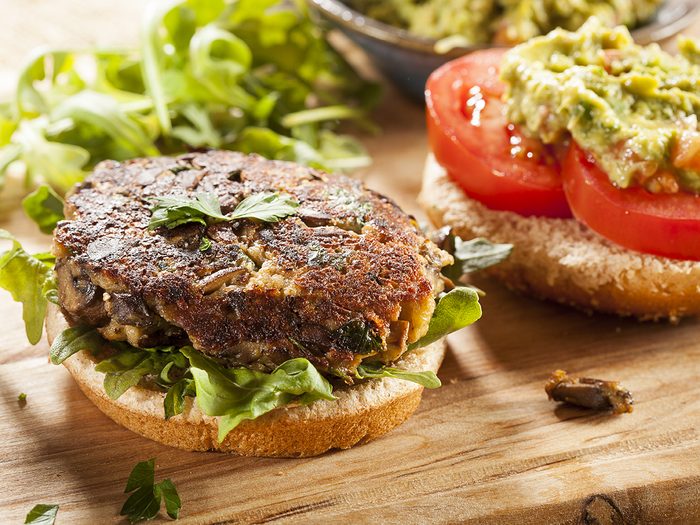
Mushrooms
Are you looking to trim the fat and calories from classic dinners like tacos, meatloaf, and burgers? Move from the meat aisle and head to the produce sections to bag some mushrooms.
“They’re one of the few veggies that exhibit umami, that savoury taste sensation, so they can be exchanged for some meat items, the way a portobello cap can be exchanged for a beef patty in a hamburger,” notes Van Workum.
This flavour profile makes it an easy addition to your meals, and one of the best vegetables for weight loss.
For comparison, one cup of crimini mushrooms is about 19 calories. A cup of beef (85 percent lean) is around 215 calories. You can even make a delicious mushroom jerky to pack for your next hike.
Check out these 10+ plant-based foods to incorporate into your diet today.
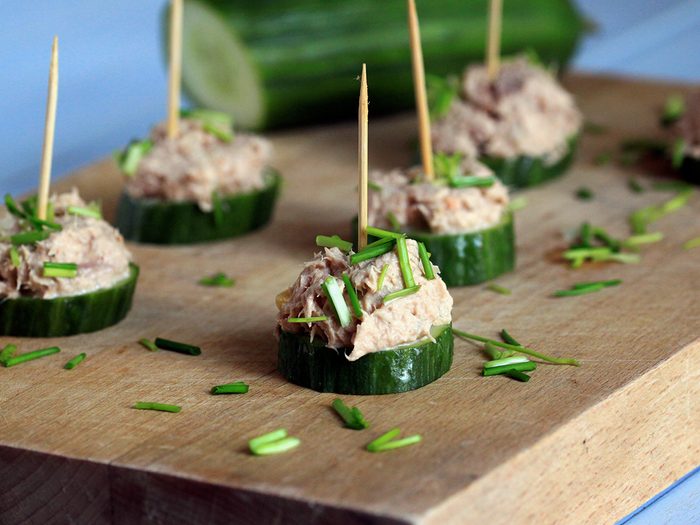
Cucumber
If you’re looking to take in more fibre, vitamin K, and potassium, put the peeler away. Cucumbers are one of the veggies you shouldn’t peel.
Of course, you could go the standard route and eat cucumbers dipped in hummus or tossed in a salad, by why not slash calories more creatively? Brockdorf uses cucumbers in place of bread for sandwiches.
Keep the skin on for a sturdier “bread,” and cut them lengthwise. Fill with lean deli meat and/or additional veggies. Or try making a cucumber fruit salad.
“Think red onion slivers, cucumber, tomatoes, and peaches tossed with red wine vinegar, salt, pepper, and a little olive oil,” says Majumdar. While you’re slicing cucumbers, save some for a refreshing pitcher of water to keep on hand in the fridge.
These infographics show when fruits and vegetables are in season for every month of the year.
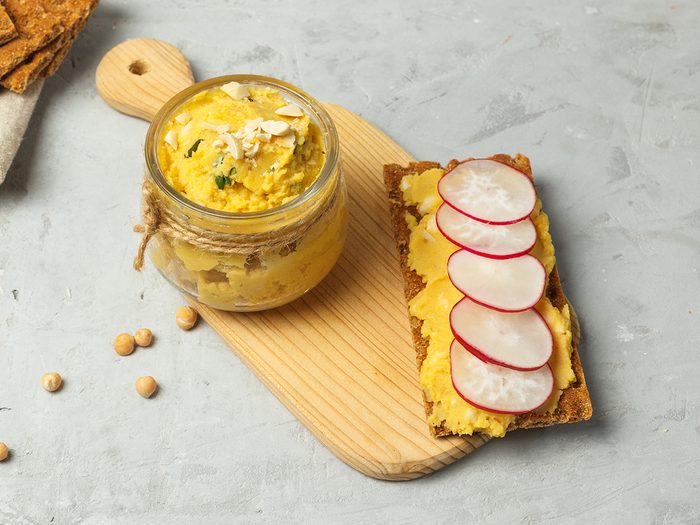
Radishes
A radish has so much more to offer than being carved into a pretty flower garnish.
For starters they are very low in calories—around 18 calories per cup with about two grams of fibre and a surprising 14 percent of the daily recommendation for vitamin C. Plus, they lend a helping hand when it comes to metabolic health.
“Radishes enhance the production of a peptide called adiponectin that modulates glucose and fatty acid regulation,” says Brockdorf. Studies suggest decreased adiponectin levels can contribute to obesity, type 2 diabetes, and cardiovascular disease, according to the International Journal of Molecular Sciences.
Toss them on a salad, dip them in hummus or make savoury veggie chips.
Discover the fruits and vegetables you should and shouldn’t peel.
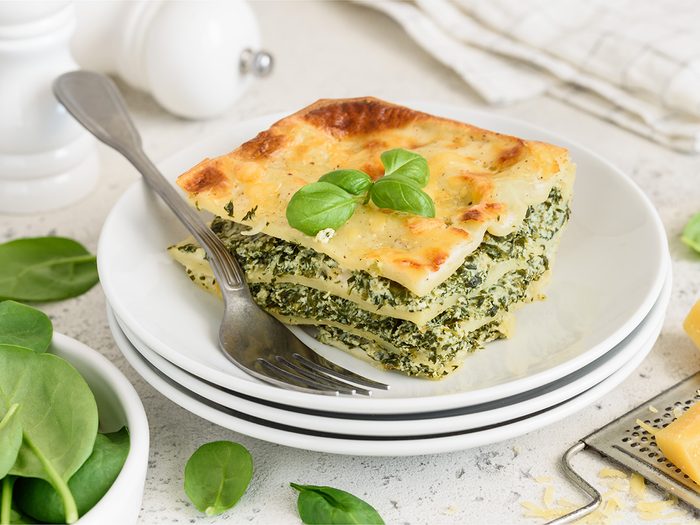
Spinach
A heaping pile of spinach is a regular standby on Majumdar’s lunch plate. She likes to add a cup of spinach to leftovers, layered on sandwiches, or in a salad with red pepper strips and slivered almonds.
Toss some in lasagna or scrambled eggs to boost your veggie score for the day. You can layer on a hearty handful (one cup) and still only consume about seven calories.
Besides the taste, she eats it for magnesium, potassium, B vitamins, and vitamin K, which are essential for blood clotting. However, if you’re on blood-thinning medications, Brockdorf says to check in with your doctor before eating too much spinach.
Here’s another bonus, spinach can help with constipation because it is high in insoluble fibre, absorbing water and other materials to help stool formation.
Discover the 13 foods nutritionists never eat late at night.
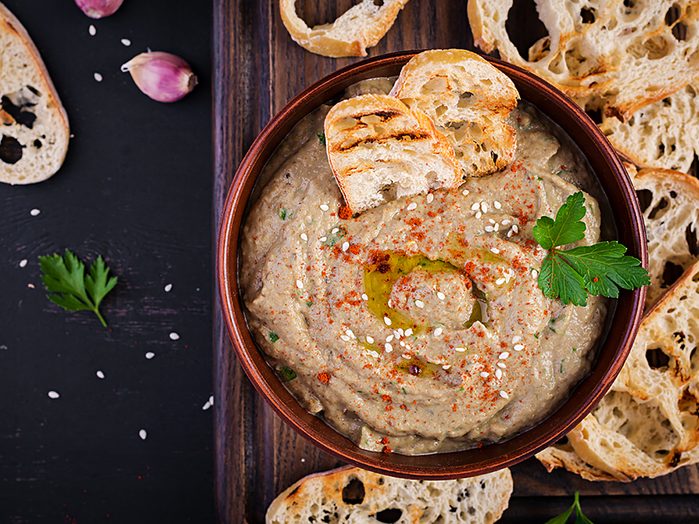
Eggplant
The pretty deep purple skin isn’t the only thing the eggplant has going for it. Its secret weight loss power is its versatility.
It can be a flavourful swap for higher calories food make it one of the best vegetables for weight loss.
“They’re kind of like a meaty texture, like a portabella or eggplant steak,” says Van Workum.
Its meaty-like texture makes it a good swap for meat dishes, cutting calories, and saturated fat. And because it’s only around 20 calories per cup and about three grams of fibre, you can eat more and feel fuller.
If you want to ease into eggplant, try something more simple.
“Roast and blend eggplant and blend into baba ganoush and use it in place of mayonnaise, ” says Van Workum. If you’re not familiar with baba ganoush, it is similar to hummus and makes a thick and yummy dip for veggies.
Here are eight clear signs you’re not eating enough vegetables.
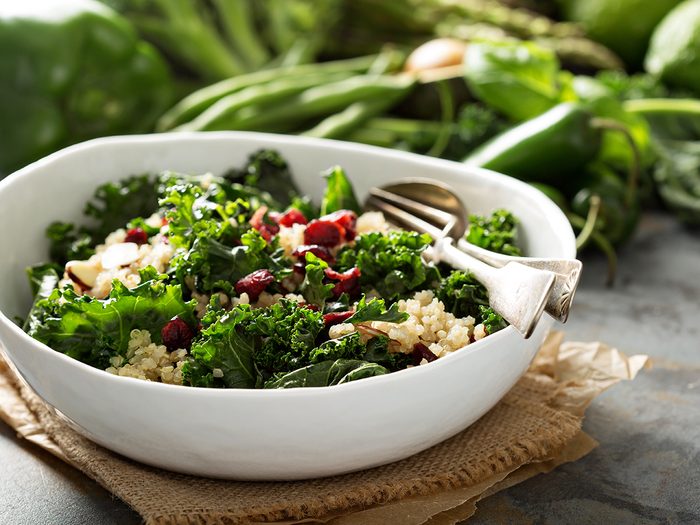
Bitter greens
If you’re not a big fan of bitter greens, you might want to give them a second shot. These leafy greens are rich in iron and can pump up the volume of food you can eat for very few calories, Van Workum says.
Bitter greens such as kale, watercress, arugula, and collards are ideal for smoothies, soups, healthy pasta, and stir-frys.
Because they tend to wilt and shrink when cooked, you can toss handfuls of raw bitter greens to bulk up any meal. Meanwhile, you’re getting loads of vitamins and minerals, antioxidants, and even a bit of protein.
One cup of raw kale has an impressive two grams of protein and about 33 calories, but you can toss in three cups and still be under 100 calories because it cooks down.
Next, check out the 13 superfoods nutritionists eat every fall.